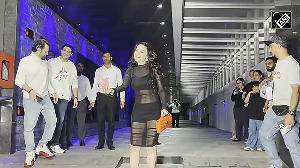Consider this:
- 94% of the audience lies within the 18-45 age group. A generation accustomed to keeping in touch i.e. via e-mail, Sms and instant messaging. A prime demographic of moviegoers.
- 78% of the audience is either a graduate / postgraduate with 56% of them are executives in their professional capacity representing an assured spending power.
- An aberration from the perceived norm of a metro bias. Responses were evenly divided between a 51%-49% metro-non metro divide.
- 68% of the audiences have a personal computer, with 50% part of a 2-television set household.
-
92% of the populations have been using the Internet for 1-5 years, highlighting an online pedigree. 52% access Internet from home. 80% are online for more than 5 hours a week with 30% use the Internet for more than 20 hours a week. An indication of online activity as becoming part of daily activity.
- 55% use the Internet for chatting, a very vocal community which can be used to promote viral marketing -- as they can handle 'multiple conversations.' Internet and mobile phones play a very important role into this generation's wish for flexible communication at home, work and during down time.
- 58% use the Internet 'to answer surveys' -- A market researcher's dream -- which has hardly been used.
- 30% are online for more than 20 hours a week. 34% spend 5-10 hours a week watching television. 32% reading newspapers for 3-5 hours a week. This clearly shows that Internet is a permanent part of media consumption habits along with TV & Print.
- 55% of an online audience watches one+ movie per month in the theatre.
- 86% have mobiles , an opportunity to exploit -- 41% postpaid and 45% prepaid
-
47% would pay for film-related mobile content and do not mind SMS contests and alerts. 70% prefer ringtones, 44% prefer SMS contests and SMS alerts and with 22% use the mobile for surfing the Internet, and one information source can reinforce the other.
The Internet & Online Association (IOAI), a not-for-profit industry trade organisation, has in its latest research pointed out that the Rs 20,000 crore (Rs 200 billion) Indian entertainment industry has not yet realised the potential of marketing on the Internet.
The IOAI research report conducted in collaboration with Cross-Tab Marketing Services, pioneers in online research, covered a sample base of 6,200 Internet and mobile users. It is estimated that India has about 37 million mobile users and 25 million Internet users.
The research report, on the Internet user's proclivity for the entertainment industry, pointed out that while film marketers have a substantial presence online they do nothing to advertise their films online.
Commenting on the release of the research, President, Internet and Online Association, Preeti Desai said: "The Indian entertainment industry stands at over Rs 20,000 crore and is expected to reach Rs 45,000 crore (Rs 450 billion) by 2009. Film marketers (films are currently a Rs 5,650 crore market) do not promote their films online and have almost negligible focus on advertising related film-related e-commerce (online ticketing, film merchandise inclusive of audio and video CDs and DVDs, posters and star clothes)."
The research was undertaken with a view to empower this sector with actual statistics and to create a realization amongst movie house and film channels that their prime demographic is online and thus "e" and "m" marketing models should be an integral part of their media mix.
"The report in itself is a research one but should act as a bible for marketers who on reading this will realise the potential and know how of being online. IOAI estimates that there will be 165 million interactive users in the 20-40 years age group by 2007, an affluent demographic who cannot be ignored anymore," she said.
The research report is a first as part of a series of research assignments addressing various industries to be duly published. The research was undertaken to understand the 25 million-strong Internet users' plus 37million mobile users' media habits and for it be a resource for marketers for film channels and production houses to get more 'butts on seats' and 'eyeballs watching their movie channels' and a realisation to integrate 'e & m marketing models' in their traditional media mix.
Whilst many a traditional marketer has endeavored to cater to the influence of this growing demographic it was pertinent to show case the importance of integrating the Internet and mobile as a vital medium in the traditional media mix to highlight new age patterns that influence the decision making process.





 © 2025
© 2025